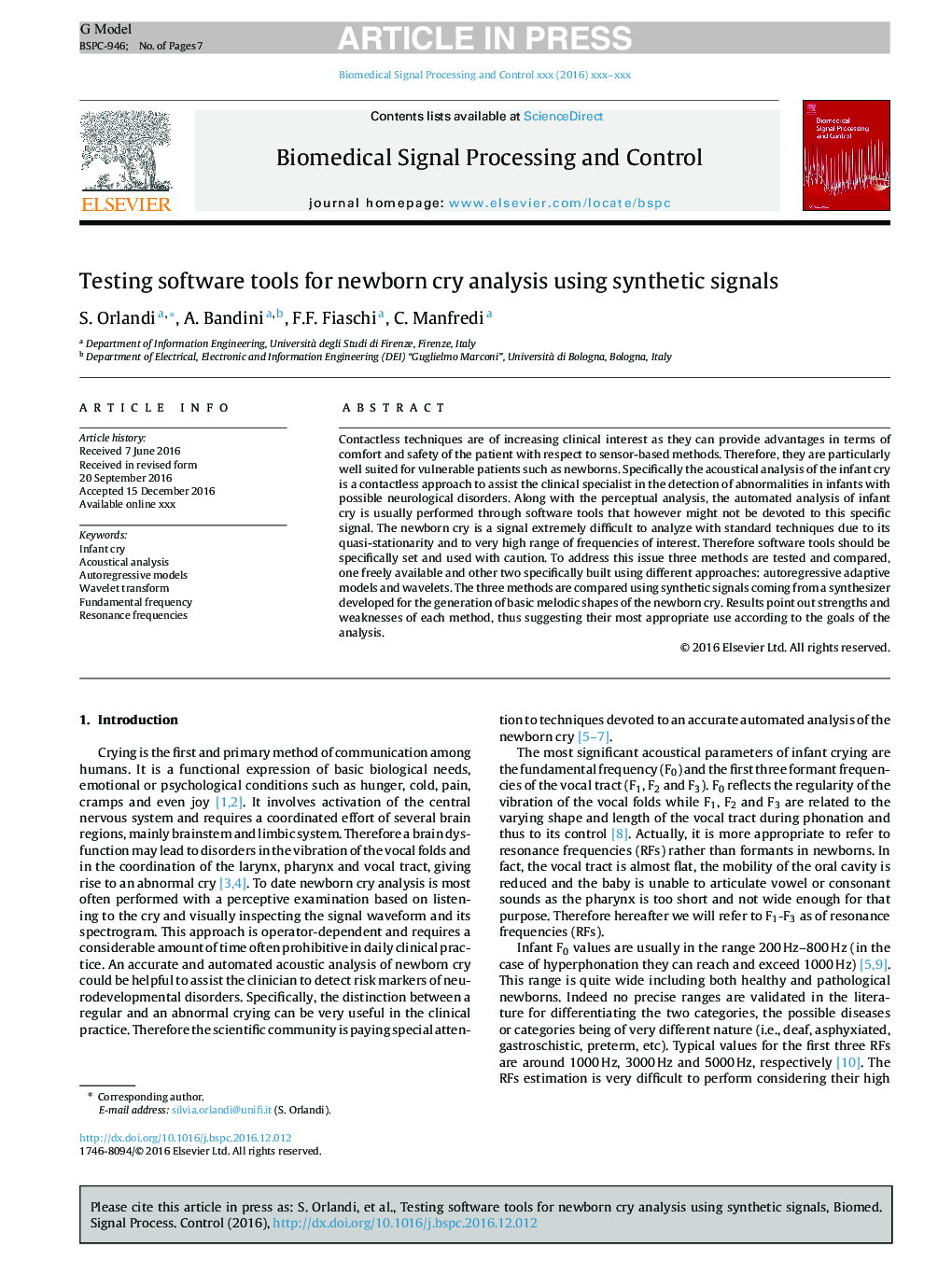| کد مقاله | کد نشریه | سال انتشار | مقاله انگلیسی | نسخه تمام متن |
|---|---|---|---|---|
| 4973409 | 1451643 | 2017 | 7 صفحه PDF | دانلود رایگان |
عنوان انگلیسی مقاله ISI
Testing software tools for newborn cry analysis using synthetic signals
ترجمه فارسی عنوان
تست ابزار نرم افزار برای تجزیه و تحلیل گریه نوزادان با استفاده از سیگنال های مصنوعی
دانلود مقاله + سفارش ترجمه
دانلود مقاله ISI انگلیسی
رایگان برای ایرانیان
کلمات کلیدی
گریه نوزاد تجزیه و تحلیل آکوستیک، مدل های خودمراقبتی، تبدیل موجک، فرکانس اساسی، فرکانس رزونانس،
ترجمه چکیده
تکنیکهای بدون تماس با افزایش علاقه بالینی مواجه می شوند، زیرا آنها می توانند از لحاظ راحتی و ایمنی بیمار با توجه به روش های مبتنی بر سنسور مزایایی را ارائه دهند. بنابراین، آنها مخصوصا برای بیماران آسیب پذیر مانند نوزادان مناسب هستند. به طور خاص، تجزیه و تحلیل آکوستیک گریه نوزاد، یک رویکرد بدون تماس است تا به متخصص بالینی در تشخیص اختلالات در نوزادان مبتلا به اختلالات عصبی احتمالی کمک کند. در کنار تجزیه و تحلیل ادراکی، تجزیه و تحلیل خودکار گریه نوزادان معمولا از طریق ابزارهای نرم افزاری انجام می شود که ممکن است به این سیگنال خاص اختصاص نداشته باشد. گریه نوزاد جدید سیگنالی بسیار دشوار است که با استفاده از تکنیک های استاندارد به علت تقریبا ناسازگار و طیف وسیعی از فرکانس های مورد علاقه، آنالیز شود. بنابراین ابزارهای نرم افزاری باید به طور خاص تنظیم و مورد استفاده قرار گیرد با احتیاط. برای رسیدگی به این موضوع، سه روش تست شده و مقایسه می شود، یکی به طور آزاد در دسترس و دو مورد به طور خاص با استفاده از روش های مختلف ساخته شده است: مدل های سازگاری اتخاذ شده و موجک. سه روش با استفاده از سیگنال های ترکیبی از یک سینت سایزر توسعه یافته برای تولید شکل های ملودیک پایه گریه نوزاد جدید مقایسه می شود. نتایج نشان می دهد که نقاط قوت و ضعف هر یک از روش ها، به این ترتیب مناسب ترین استفاده را مطابق با اهداف آنالیز نشان می دهند.
موضوعات مرتبط
مهندسی و علوم پایه
مهندسی کامپیوتر
پردازش سیگنال
چکیده انگلیسی
Contactless techniques are of increasing clinical interest as they can provide advantages in terms of comfort and safety of the patient with respect to sensor-based methods. Therefore, they are particularly well suited for vulnerable patients such as newborns. Specifically the acoustical analysis of the infant cry is a contactless approach to assist the clinical specialist in the detection of abnormalities in infants with possible neurological disorders. Along with the perceptual analysis, the automated analysis of infant cry is usually performed through software tools that however might not be devoted to this specific signal. The newborn cry is a signal extremely difficult to analyze with standard techniques due to its quasi-stationarity and to very high range of frequencies of interest. Therefore software tools should be specifically set and used with caution. To address this issue three methods are tested and compared, one freely available and other two specifically built using different approaches: autoregressive adaptive models and wavelets. The three methods are compared using synthetic signals coming from a synthesizer developed for the generation of basic melodic shapes of the newborn cry. Results point out strengths and weaknesses of each method, thus suggesting their most appropriate use according to the goals of the analysis.
ناشر
Database: Elsevier - ScienceDirect (ساینس دایرکت)
Journal: Biomedical Signal Processing and Control - Volume 37, August 2017, Pages 16-22
Journal: Biomedical Signal Processing and Control - Volume 37, August 2017, Pages 16-22
نویسندگان
S. Orlandi, A. Bandini, F.F. Fiaschi, C. Manfredi,
